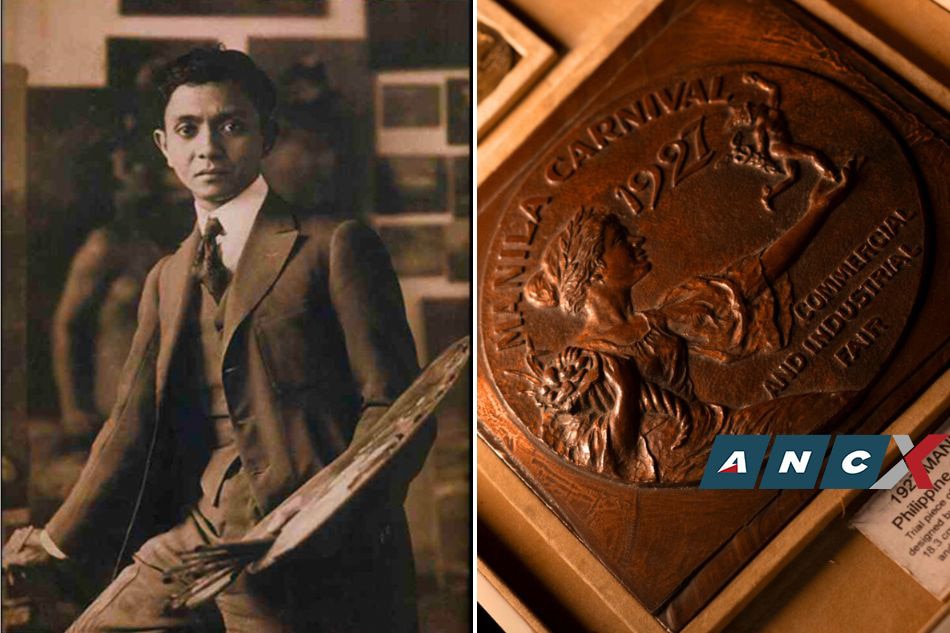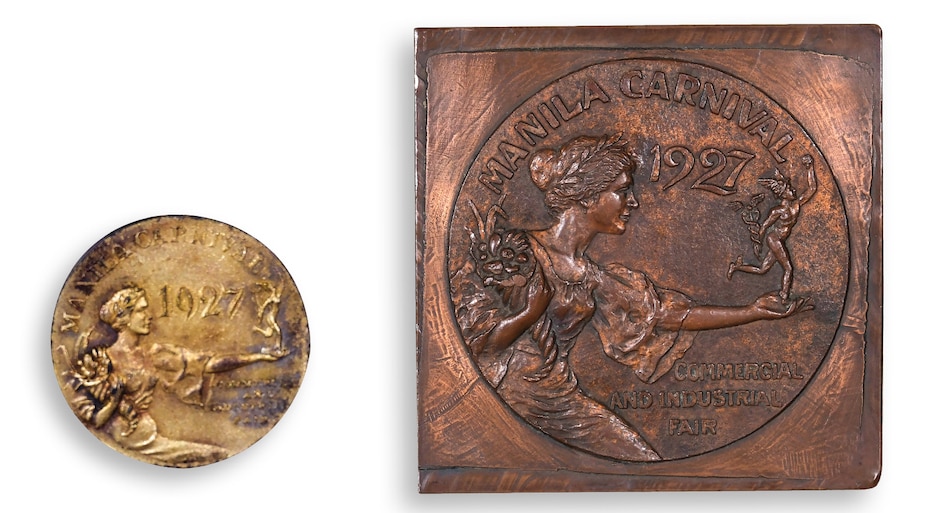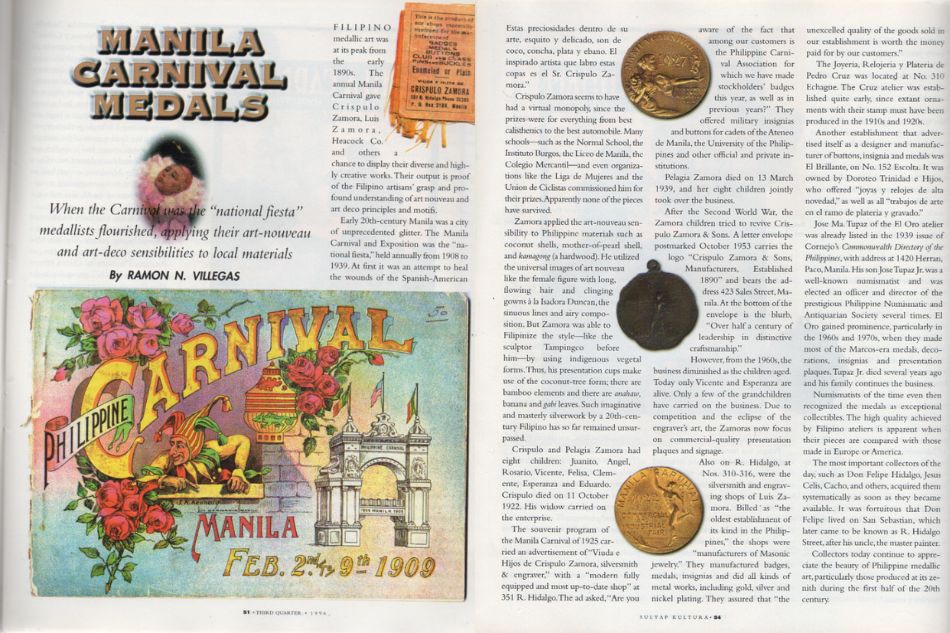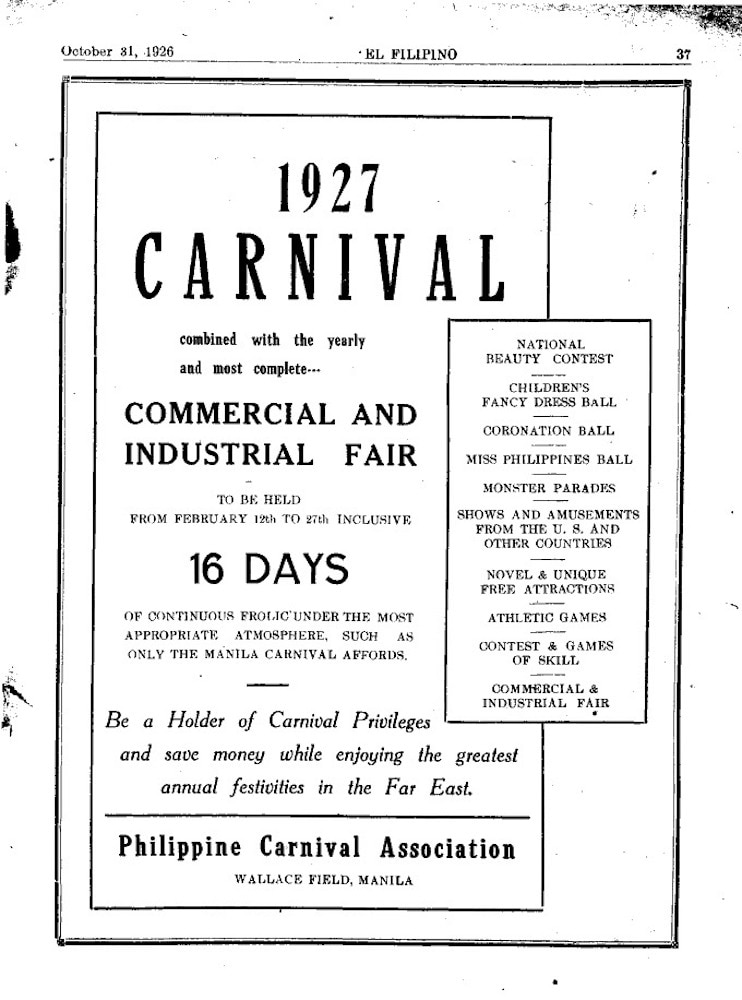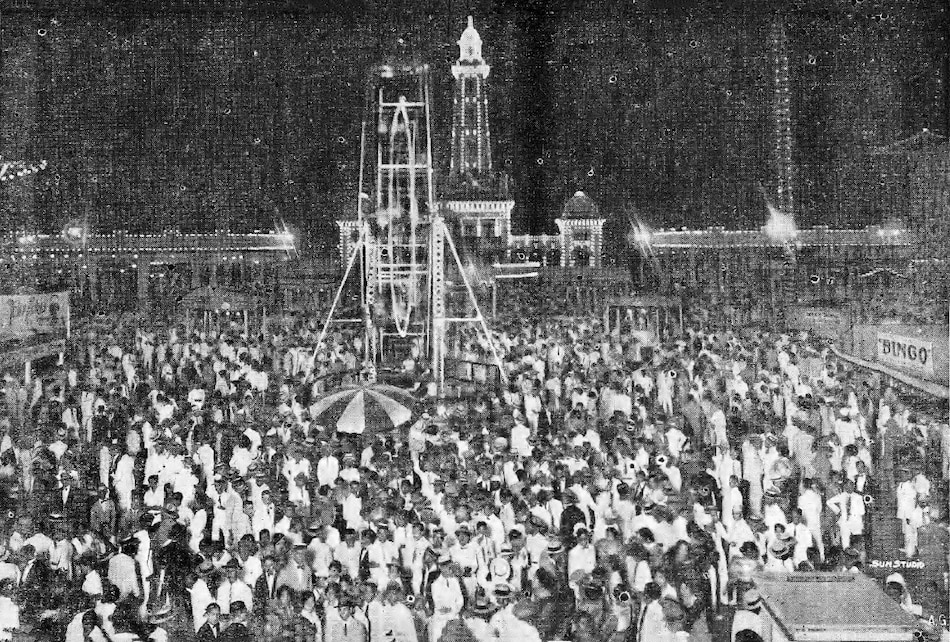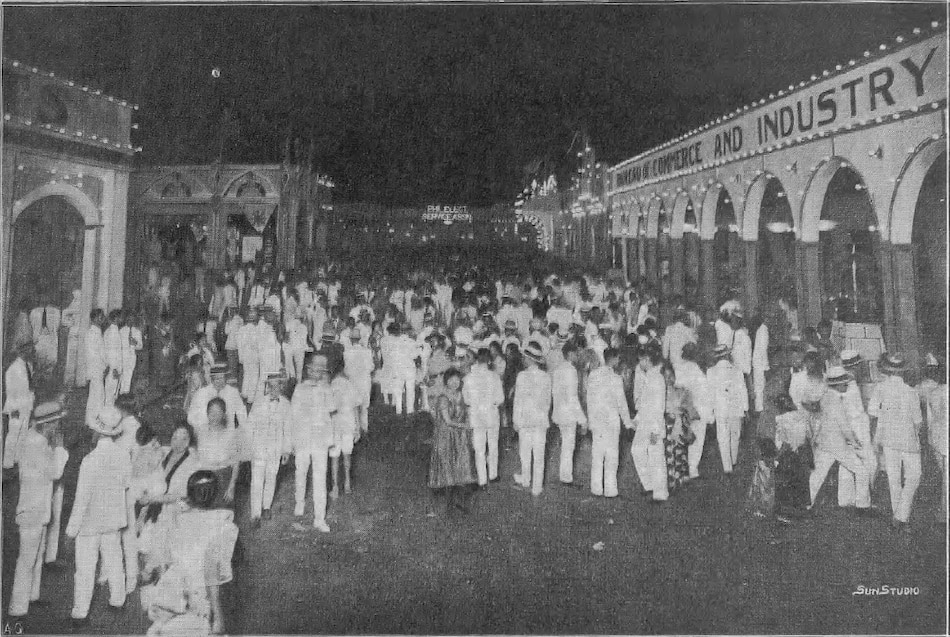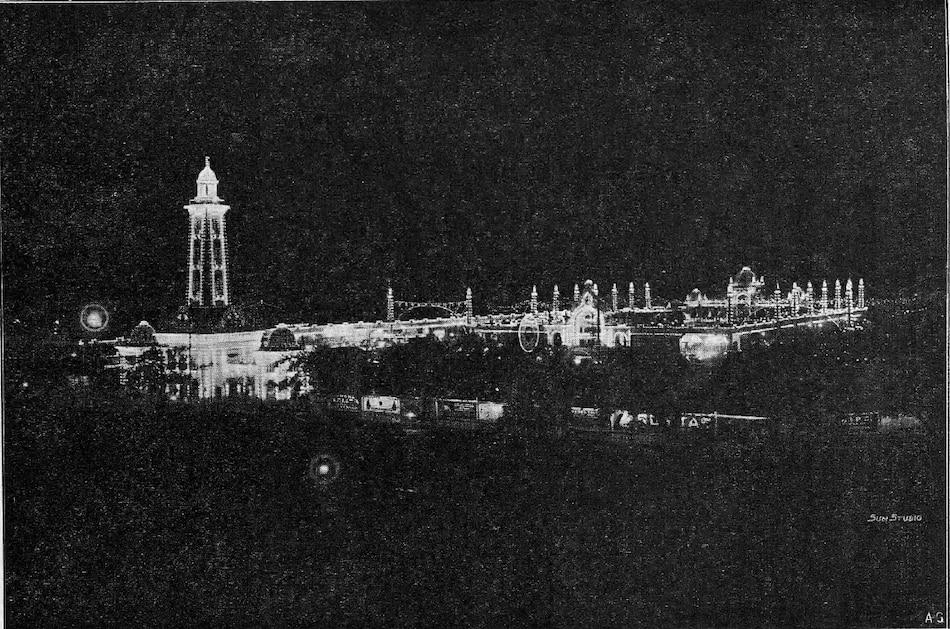The rare bronze engraving shown above, designed and created by Fernando Amorsolo, stands as a silent witness and enduring symbol of a bygone era in Philippine history — the pre-war years of the Manila Carnival.
The storied Manila Carnival was first held in February 1908, six years after the formal end of the Philippine-American War and the establishment of the Insular Government of the Philippine Islands. Organized by the Philippine Carnival Association, the Manila Carnival showed off the Philippines’ commercial, industrial, agricultural, and economic development and advancement under the new colonial masters.
The Carnival, held at the old Wallace Field in Luneta, was consistently advertised along the lines of “The Greatest Annual Event in the Far East” and “The Ideal Time to Visit the Philippines.” The highlight of the fête was the crowning of the Carnival Queen, a title first accorded in 1908 to Pura Villanueva (Queen of the Orient; she was the very first ‘Miss Philippines’) and Marjorie Radcliffe Colton (Queen of the Occident).
It was the absolute indication of Manila’s indisputable prominence as the “Pearl of the Orient” during peacetime.
A momentous occasion like the Manila Carnival required the brightest minds in its promotional lineup, and one such man was Amorsolo, who had a colorful connection with the famed Manila Carnival.
Being one of the leading young artists of his time, Amorsolo won several commissions to create promotional posters for the Carnival, particularly the 1924, 1930, and 1934 iterations.
Amorsolo also had the privilege of designing several of the medals awarded to the Carnival’s various competitions, including the best exhibits and art contests. “The most famous designs were the 1914 Philippine Exposition and the 1922 and 1927 Manila Carnival medals made by National Artist Fernando Amorsolo,” wrote historian Emmanuel N. Encarnacion in the 1996 edition of Sulyap Kultura, the official publication of the National Commission for Culture and the Arts.
The broze engraving crafted by Amorsolo for the medal prize of the 1927 Manila Carnival depicts a dalaga dressed in a baro’t saya (a typical Amorsolo subject). On her head sits a wreath of laurel leaves, symbolizing victory. The dalaga is portrayed holding Mercury, the Roman god of commerce and progress. The deity is highlighted by his caduceus and trademark winged helmet and sandals.
Interestingly, Amorsolo was conferred two first prize awards: one for landscape painting and the other for general painting at this same event. This makes this historic piece a representation of a full-circle moment for the then-35-year-old Amorsolo. (Amorsolo also won the first prize in the painting competition of the 1922 Manila Carnival, the first time an art competition was held for the event.).
More fascinating is this bronze artifact’s publication in the above-mentioned Sulyap Kultura, which also serves as its authenticating paper. In Encarnacion’s essay “The Medallic Art of Philippine Carnivals, Expositions, and Fairs,” he described this work as a “big trial piece in bronze…designed by Fernando Amorsolo.” Also in the same journal, the late Ramon N. Villegas wrote in his article “Manila Carnival Medals”: “The medals were designed after the annual theme and the main visual concepts developed by the top graphic artists of the day, including Fernando Amorsolo.”
Accompanying this important bronze memento at hand is the original gilt bronze medal awarded to a grand prize winner at the 1927 festivities. This piece was featured in Villegas’ essay, also published in Sulyap Kultura. In his essay, Villegas wrote: “When the [Manila] Carnival was the ‘national fiesta,’ medalists flourished, applying their art-nouveau and art-deco sensibilities to local materials…The medals were designed after the annual theme and the main visual concepts developed by the top graphic artists of the day, including Fernando Amorsolo.”
The 1927 iteration of the Manila Carnival was considered one of the grandest at that time, drawing nearly half a million attendees through the famed gates of Carnival City. Alongside impressive exhibition booths from Philippine provinces as well as local and American businesses, the great nations of China and Japan made notable representations. The event featured art competitions for public amusement, and because of the tremendous success of the 1926 edition, the Second National Beauty Contest was reintroduced.
An excerpt from the foreword of the 1927 Manila Carnival Commercial Handbook wrote: “Once more, the Manila Carnival approaches. This yearly event in the Philippines which will take place from the 12th to the 27th of February 1927, has long been widely known in the Far East and elsewhere as a big center of commercial exhibitions and amusements. Its popularity is such that while the carnival lasts, Manila is easily the busiest, liveliest, and gayest city in the whole Orient.”
In the early 1920s, Amorsolo was on the cusp of being the brightest name in Philippine art, although his recognition was primarily among American patrons rather than the Filipino general public. By 1925, he had begun to be recognized internationally, particularly in the US. That year, he had his first exhibition on American soil in New York City’s famous Art Center Gallery. This opportunity arose when an American client, Capt. Robert Kennedy, brought some of the maestro’s paintings to be framed at the Art Center. But the gallery's owners showed interest in Amorsolo’s works, prompting Capt. Kennedy to arrange for a one-man show, Alfredo Roces wrote in his monograph titled “Amorsolo.”
The landmark show was a near sell-out, attracting “many Americans who had been to the Philippines or were interested in the country,” remarked Roces. The August 15, 1927 issue of The Philippine Republic described the exhibition as something that “occasioned the most favorable comment, both upon the high quality of the artist’s works, as well as upon the cultural advancement of the native Filipino, which Amorsolo’s accomplishments indicate.”
But it was the 1927 Manila Carnival, where he earned national acclaim, coupled with the significant international exposure mentioned earlier, that propelled Amorsolo to become a household name. The Carnival that year recorded the third-highest attendance of all its editions up to that point, with 467,619 attendees from around the world. This greatly contributed to Amorsolo's much-needed national exposure. "By 1928, his name was a national byword," Roces remarked.
Amorsolo’s popularity was attested by numerous periodicals of that time. For instance, in its June 1928 issue, The Philippine Magazine praised Amorsolo’s color scheme and handling of light as “more original than either Luna’s or Hidalgo’s.” (Amorsolo’s works were even included in a landmark exhibition in 1928 at the Ayuntamiento in Intramuros, alongside masterpieces by Luna, Hidalgo, Fabian de la Rosa, and other titans of Philippine art). Its issue, dated September 1929, featured as its cover Amorsolo’s circa 1922-23 painting of “Martin de Goiti Meeting with Rajah Soliman” from the collection of his patron Don Enrique Zobel.
“In those days [pertaining to the early 1920s], Mr. Amorsolo was not so well-known and prosperous as he is today,” remarks the magazine. The 1928 issue of The Philippine Republic christened Amorsolo as the most famous painter in the country, featuring him alongside sculptor Guillermo Tolentino as “The Philippines’ Most Famous Artists.”
An excerpt of the full quote from the Roces monograph regarding Amorsolo’s dominance and popularity by the late 1920s writes:
“Amorsolo’s dominance of the local art scene had become almost total. He was something of a celebrity. He appeared in full-page advertisements…Poems were written in his honor. [He] was ubiquitous judge of [the Manila] Carnival beauty queen contests. His previous employment with the press had, of course, given him many friends there. When he first received public notice by winning a carnival poster design in 1913, the Daily Bulletin had referred to him as ‘Omorsolo,’ while the Manila Times identified him as ‘Amarsolo,’ but by 1928, his name was a national byword.”
The Kingly Treasures Auction is happening this December 2, 2 p.m., at Eurovilla 1, Rufino corner Legazpi Streets, Legazpi Village, Makati City. Preview week is from November 24 to December 1, 2023, from 9 a.m. to 7 p.m. For further inquiries, email info@leon-gallery.com or contact +632 8856-27-81. To browse the catalog, visit www.leon-gallery.com.
Follow León Gallery on their social media pages for timely updates: Facebook and Instagram @leongallerymakati.


